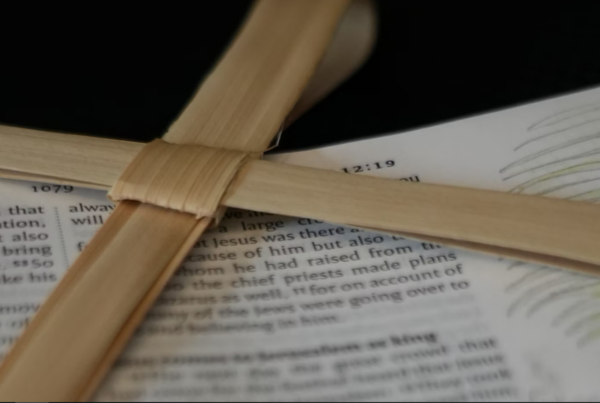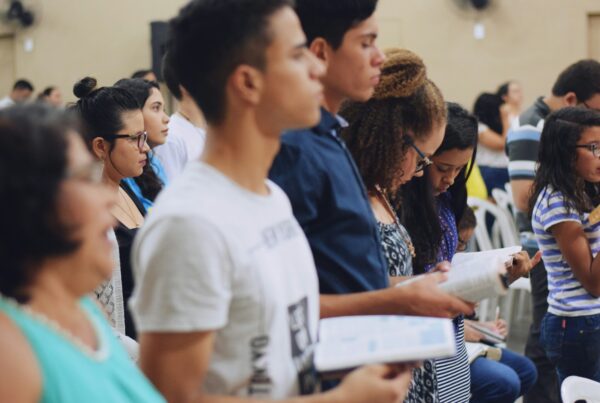I recently saw this wire sculpture by Ruth Asawa on display in a local museum. I was intrigued by the intricate beauty of the woven wire and the complexity of its lines. I couldn’t decide if the sculpture was drawing my attention in towards its center or out onto the gallery wall and beyond.
Both directions seem to be a metaphor for the church.
Drawn in
Being a part of the church means I have a community of believers to join on Sundays with whom I experience the presence of the divine. It means I have a physical place to go that encourages me to reach inward and connect with God on a weekly basis.
And in this inward turning, I am sustained and renewed by the worship, prayers, and pastors’ teachings. I am supported by the love and care of my fellow congregants. Once last year, when I had tough week, a friend from church made a double portion of dinner for her family and brought my family dinner too. A simple act with great love; actions like this and other kindnesses ripple throughout the congregation every week, too many to count.
This is the drawing inward, the core of church for me. The corporate confession, the congregational singing of the Kyrie and the familiar faces: these remind me I am not journeying alone. I travel inward to known peace and known people, to the worn beauty of the space and the songs that I’ve memorized. I seek and find restoration and connection for myself, just as the pieces of wire in the sculpture are tied together forming a central star.
These remind me I am not journeying alone.
Propelled out
And yet, the same lines that draw my eye inward also push it out, beyond the edges of the sculpture. As I soak up the known and familiar patterns of corporate faith in worship, I see the church moving out into the community and world. Each week during the offering, I watch children pull a red food pantry wagon down the center aisle. Congregants pass boxes of cereal and canned goods to eager young hands that place them in the wagon. This food moves on to the local food pantry after service.
Looking outward also means we might get up at 4:00 a.m. and pile into the church van to drive to Washington, D.C. We join other churches and Bread for the World to advocate on behalf of the hungry. Reaching beyond ourselves and with volunteers from other churches and college students on spring break, we help rebuild homes after Hurricane Sandy. Others join us, moving out in their faith too.
This outward reaching leads to an opening of church doors for us and a sharing of our church’s physical space as well. The Hurricane Sandy volunteers stay in our building, their cots set up in the Sunday school classrooms. Senior citizens take classes there, like art and opera appreciation. A Jewish minyan meets in our building on Saturday mornings, and a Buddhist prayer and meditation group is there one evening a week. Our undocumented brothers and sisters in faith have taken literal sanctuary in our church building, some of them living there for months on end. The open doors and the church’s outward movement are a conduit, ushering in God’s grace.
Church can be messy and tiring, even painful.
Points of pain and beauty
I notice that the places where this sculpture is tied together are like little barbs. The outward-reaching element of the church can be messy and tiring, even painful.
Sometimes our building is not as clean as I would like, sometimes the wear and tear gets ahead of us. Sometimes things get taken from the classrooms or lost, and the bathroom runs out of toilet paper. The hallways are often crowded. Sometimes there’s not a quiet space to be found for a church-related meeting, and the “Listening to Opera” class next door seems longer than two hours. Sometimes the children pulling the food pantry wagon push each other and the Sunday trip down the aisle is less about generosity and more about jockeying for a prime position. Or someone uses the prayer chapel as a place to chat on their phone.
Sometimes, though, the red wagon overflows with winter socks and canned food and there aren’t enough children to collect the bounty. The vast array of ages and languages and people from all walks of life and faith traditions means God’s whole beloved world is constantly before my eyes. And sometimes when I’m in my office on a Saturday morning, I hear the minyan singing their prayers. I am drawn into God’s presence and filled up and sustained, and it’s not even Sunday yet.
Wendy Jager
Wendy Jager is on staff at the Reformed Church of Highland Park in New Jersey. She also works part time for Interfaith-RISE, a branch office of the U.S. Committee for Refugees and Immigrants.



